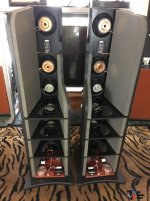Hello all. I have a question. I am wondering how to calculate the dimensions of an open baffle speaker. The speaker I have in mind is somewhat similar to Danny Richie's NX Otica, but I struggle to understand a few parts of his cabinet design. Particularly, the asymmetry of the side wings for the mid/hi section. I understand the purpose of these wings to be to help lower the cancellation frequency band, but I do not understand why the NX-Otica speaker has taken half of one of the wings and chopped off a huge section.
Is it to help reduce cavity resonance, and if so, how do you know how to calculate how much of the wings to chop off? I see that for the bass section of the speaker, the NX-Otica does not have tapered wings. Should I take this to mean that whatever issue this practice corrects is not presence in the bass section of an open baffle?
If the reason for this is cavity resonance, is cavity resonance not something I have to worry about as much in the bass section? Or is it just a tradeoff for extension? I assume cavity resonance is still somewhat of a factor because Danny uses plenty of his No Rez material in the bass part as well.
Anyways, riddle me confused. Can anyone help? Thanks!
Is it to help reduce cavity resonance, and if so, how do you know how to calculate how much of the wings to chop off? I see that for the bass section of the speaker, the NX-Otica does not have tapered wings. Should I take this to mean that whatever issue this practice corrects is not presence in the bass section of an open baffle?
If the reason for this is cavity resonance, is cavity resonance not something I have to worry about as much in the bass section? Or is it just a tradeoff for extension? I assume cavity resonance is still somewhat of a factor because Danny uses plenty of his No Rez material in the bass part as well.
Anyways, riddle me confused. Can anyone help? Thanks!
Attachments
Apparently he used trial n' error via measurements to find whatever optimum in-room response he was wanting, so odds are you will too unless the Edge software is powerful enough to do it.
You assume right.
You assume right.
Ah jeez. I don't much like the sound of that. Maybe I will experiment with foam core. Thanks for your response!Apparently he used trial n' error via measurements to find whatever optimum in-room response he was wanting, so odds are you will too unless the Edge software is powerful enough to do it.
You assume right.
I believe that there is nothing worth cloning there. Please study open baffle/dipole speaker design here at diyaudio and preferably these sites
www.linkwitzlab.com
www.dipolplus.de
http://musicanddesign.speakerdesign.net/NaOIIdiscus.html
www.linkwitzlab.com
www.dipolplus.de
http://musicanddesign.speakerdesign.net/NaOIIdiscus.html
